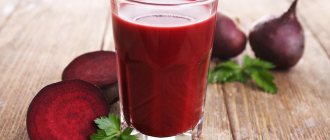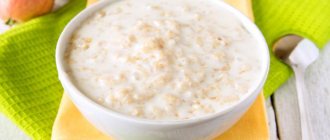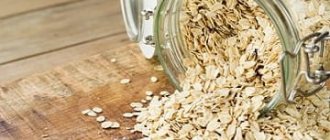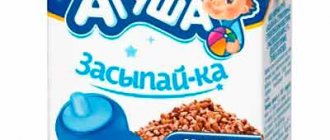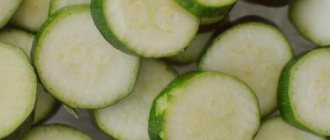Pediatricians advise introducing the first complementary foods to babies from 5-6 months, when the digestive system improves. It is advisable to start feeding with cereals, as they contain a large amount of useful substances and microelements, thanks to which the child grows quickly and gains weight, and receives all the necessary nutrients.
The first porridge for complementary feeding
must be properly selected so as not to cause harm to health.
Expanding a baby’s diet is a responsible process; it is important for parents to know which porridge
is best
to choose for
the very
first complementary feeding
?
…
Why do infants need complementary foods?
Breast milk contains many useful substances and vitamins that help newborns grow and fully develop. For the first 4-5 months, babies are fed exclusively with breast milk; there is no better nutrition for newborns. A pack of artificial formula does not contain as many useful substances as breast milk.
Important!
As a child grows older, he needs more useful microelements and vitamins. Activity requires energy, which can be obtained through proper nutrition.
Complementary feeding provides the baby with all the necessary substances and vitamins that are required in larger quantities.
Thanks to cereals, children learn to chew, which contributes to early speech and strengthening of facial muscles. With the help of food, the baby satisfies his curiosity and gets to know the world that surrounds him.
Previously, doctors advised starting complementary feeding from 3 months of age . According to the latest WHO data, this should be done no earlier than 6 months, provided that you are breastfed.
Interesting! How much should a newborn eat at one feeding?
When a child is fed artificial formula, additional nutrition is given from 5 months. If new foods are introduced before this age, it will not benefit the baby, since the digestive organs are not yet fully formed.
Feeding with porridge: nuances
In this case, the concept of “norm” is very conditional. It also depends a lot on the baby himself, since some children are full of mother’s milk for up to a year, and some children from 4 months to six months have a wild desire to get acquainted with the contents of their mother’s plate. According to average standards, early complementary feeding is done when the baby reaches four months. If done later than 6 months, it can distort the formation of chewing skills and lead to serious stress on the gastrointestinal tract.
The term “complementary feeding” covers everything that is given to the child in addition to breast milk or formula. All juices, decoctions, purees, cereals, as well as products of animal origin are what need to be gradually introduced into the baby’s diet.
New food should not feed the baby at first: on the contrary, the purpose of this event is only to acquaint him with what you eat. Remember: dishes at this stage should be devoid of sugar, salt and seasonings, as the child’s body may give an inadequate reaction to this. Refrain from adding salt or sweetening them: now the baby will not be able to adequately perceive a product that contains something else.
Features of introducing complementary foods
Deciding when to introduce milk cereals
, it is recommended to familiarize yourself with the algorithm for including food in a baby’s diet. It looks like this:
- Porridge recipes for children under one year of age
should contain one component - cereal. Sugar, milk, salt, flavorings and other additives are excluded. They will harm the child’s health, since the digestive system has not yet fully formed. - Milk porridges are prohibited for children under one year of age
- natural cow's milk contains fats and heavy components that the baby's body is not yet able to digest and assimilate. - Which porridge
is better
to choose for the first
feeding?
Doctors advise choosing cereals that do not contain gluten
- this is a protein of plant origin that is not digested in the body of babies. This substance is not found in only two cereals - rice and buckwheat. They should be given to children as their first food. Sometimes other types can be prepared, but this is done after a doctor’s prescription. - Semolina should not be given to children under one year of age, as it reduces the absorption of calcium, which negatively affects the development of the skeletal system. This porridge is considered heavy and causes discomfort in the baby’s tummy.
- Which porridge should I start complementary feeding with
if my baby is bottle-fed? It is recommended to give preference to buckwheat, as it is more balanced and has many health benefits. - Milk porridges for children under one year old
can be given if they are not gaining weight well. Use milk strictly according to the indications and recommendations of the pediatrician.
You should not start giving complementary foods on your own; only a doctor can tell when additional nutrition can be introduced to your baby. If the mother has little milk, then such food can be prescribed at 4 months, because it is much healthier than artificial formula.
This is interesting! Until what age should a baby be fed breast milk?
Rules for introducing porridges
To prevent complementary feeding from causing problems for the digestive system, it is important to follow the basic rules:
- For the first complementary foods, you should give preference to dairy-free one-ingredient porridges that do not contain gluten, sugar, GMOs, fructose and other artificial additives;
- Most infants tolerate rice and buckwheat well. After the baby has mastered them, you can expand his menu with corn and wheat porridge;
- It is recommended to start complementary feeding with “packaged” options available for sale in pharmacies and children's supermarkets. Why? There are a number of explanations for this: their composition is balanced; they are designed for a specific age; they are hypoallergenic; they are quick and convenient to prepare, having previously read the instructions and recommendations;
- If dairy-free cereals are well absorbed and there is no allergy, after 4-7 weeks you can introduce gluten-free dairy products, the nutritional value of which is much higher.
How to give
Children's cereals offered to a child for the first time should be 5 percent (5 g of cereal per 100 ml of water). This condition is necessary so that the consistency of the porridge for the first feeding is optimal.
The porridge should be given from a teaspoon. It is advisable to use rubberized spoons, which are specially designed for the baby’s delicate gums. The optimal time for complementary feeding is breakfast.
Important!
It happens that a child refuses to eat complementary foods from a spoon, or may refuse porridge, so we have written an article for you on how to deal with this.
Here, we wrote how to teach a child to eat from a spoon - read it.
[sc:rsa]
The introduction of complementary foods usually starts with 0.5-1 tsp. rice or buckwheat porridge. The consistency of the gruel should resemble puree. It is important to ensure that there are no lumps in the product offered to the child. After complementary feeding, the baby is offered breast or formula milk.
Every day, increase the amount of porridge offered to your child by 1 teaspoon. On the second day of complementary feeding, the child should be offered 2 tsp, on the third day - 3 tsp. etc., until a single serving is 150 g. A single dose at 7-8 months should be 160-170 g, at 8-9 months - about 170-180 g. Closer to a year, a single serving should be 200 g. Do not forget that each child is individual and accepts certain foods differently. This also applies to the volume that a baby can master in one sitting.
Over 7-10 days, the consumed volume is gradually increased to 100-150 g. For 2 weeks, it is recommended to give the child one type of porridge. Over time, the consistency should be 10% (10 g of cereal per 100 ml of water). Only with good tolerance and the absence of allergic reactions and other troubles can you begin to administer the next type.
Kinds
To understand which cereal is best to use to accustom your baby to adult food, it is recommended that you familiarize yourself with their range.
Today it is possible:
- make your own porridge;
- buy it at a pharmacy or store, and then dissolve it with warm water.
Each mother must decide for herself what to choose for cooking.
Store-bought dairy-free products do not contain sugar, starch, milk or other ingredients,
which create a serious burden on the infant’s not fully strengthened digestive system.
If the mother decides to buy the product in the store, then it is recommended to give preference to rice, corn and semolina.
They contain:
- magnesium;
- iron;
- protein;
- vitamin B.
These are the nutrients that children need in the first year of life.
Rice can be prescribed to babies who are underweight for their age. It is recommended to use rice flour rather than cereal, as it does not cause constipation in infants.
Corn grits are also important for the full development of the baby, as it contains protein, microelements and fiber.
Attention
! In the first month of starting complementary feeding, food should not contain any additives - it is prepared only from water and cereals.
For the first 2-3 months, food made from one component should be given, and as the child reaches 7-8 months, multi-ingredient meals can be used.
Which porridge should I introduce complementary foods with?
Even if the family, and the child in particular, has no predisposition to allergic reactions, complementary feeding should be introduced with gluten-free cereals. Thus, grains that contain gluten should be excluded (rye, wheat, oats, barley). Then the question arises: what porridge to start complementary feeding with?
There are three types of gluten-free cereals that are safest for children:
- buckwheat;
- rice;
- corn porridge.
Buckwheat is considered an ideal grain for first complementary feeding. It has valuable proteins, vitamins and amino acids. In addition, cereals have a low level of hypoallergenicity, saturate the body with iron, increasing the level of hemoglobin in the blood, improve intestinal motility, and relieve constipation.
Rice should be introduced into the baby’s diet after buckwheat. This is the only cereal that contains all 8 amino acids. It is hypoallergenic and helps cope with diarrhea. The only drawback is rice porridge. Complementary feeding with it should absolutely not be started for children suffering from constipation.
Corn grits are introduced into the diet no earlier than 7-8 months, after buckwheat and rice. It has a rich vitamin and mineral composition and helps get rid of constipation. Gradually, you can add healthy fruits and berries to the porridge.
What is better - cook or buy?
Before answering the question of how to
dilute porridge for the first
feeding, it is worth finding out whether it is better to buy it in a store and dilute it with water, or to cook it yourself? WHO advises parents to initially buy the product in boxes, as it is prepared using a special technology that will definitely not harm the baby. It is necessary to give preference to proven brands that have managed to gain popularity among modern parents.
Interesting! Which feeding bottles are best for newborns: rating
Store-bought mixtures have a rich composition, as well as the correct preparation technology. This product:
- enriched with large amounts of potassium, zinc, iron and magnesium;
- does not contain dyes, salt, flavors or other unnatural additives;
- endowed with a homogeneous consistency, due to which food is well absorbed by the body;
- has a completely safe composition, which does not contain heavy metals and other types of chemicals;
- undergoes careful control and is regularly assessed by experts.
The best baby cereals
out of the box are prepared from high-quality raw materials, so you don’t have to worry about the baby’s health.
But if you evaluate it from an economic point of view, it is much more profitable to cook yourself. Food from packs has a short shelf life
, and at first the baby will eat very little.
Some parents don’t trust store-bought products, so they cook for their kids themselves.
It is necessary to carefully calculate the dose of cereal, as well as maintain strict hygiene.
The easiest way to make buckwheat at home is because it cooks quickly and does not change its consistency as it cools. How to prepare buckwheat porridge for first feeding
, it is recommended to check with your pediatrician.
Varieties of baby cereals
The most suitable option for first complementary feeding is dairy-free porridge. They do not contain sugar, milk, starch, gluten or other additives. The composition of dairy-free cereals is ideally adapted to the child’s digestive system, which is not yet strong enough to digest solid food.
Buckwheat . Due to the content of protein, iron, magnesium, vitamins B1 and B2, buckwheat is considered a valuable cereal and should be a mandatory product in a child’s diet.
(Preparing buckwheat porridge)
Rice porrige. A product rich in healthy dietary fiber. Many parents mistakenly think that consuming rice can cause constipation in children. However, it is not. Rice flour, which is used to make baby food, does not contain broken rice and does not cause constipation.
(Cooking rice porridge)
Corn porridge . It surpasses even rice in terms of nutrients. Rich in protein, iron and fiber.
Oatmeal . It is considered beneficial due to vegetable protein and minerals (calcium, iron, magnesium, vitamins B1, B2, PP). The amount of fat and fiber contained in oatmeal is 6 times higher than their content in other cereals.
(Cooking oatmeal)
Experts in the field of baby nutrition recommend introducing porridge in the following order: 1 – rice; 2 – buckwheat; 3 – corn; 4 – wheat; 5 – oatmeal.
For each type, it is advisable to adhere to the established administration regimen - 2 weeks. Only after this, with normal absorption, can you begin to introduce another porridge.
Most modern mothers use packaged products for complementary feeding.
- Firstly, it's fast, simple and convenient.
- Secondly, baby food manufacturers supply proven, high-quality and balanced products that are fully adapted to the child’s body.
- Thirdly, you can choose hypoallergenic, gluten-free and dairy-free cereals, which will significantly reduce the risk of your baby developing allergies.
However, some mothers prefer to prepare porridge for their child themselves.
We cook ourselves
When you decide to cook porridge at home, it is important to know how to cook it. The following tips will help with this:
- Porridge for baby food is cooked only in water!
- Before cooking, the cereal is ground using a blender or coffee grinder.
- Cereals are taken at the rate of 5-10 g per 100 ml of water.
- Optimal consistency can then be achieved by adding formula or breast milk to the pulp.
- There is no need to add sugar and salt.
(3 recipes, see above)
List of the best cereals for infants
Our grandmothers did not have to worry about choosing cereals, since at that time semolina was considered the best, and only a few types of such food were sold in stores. Today you can find a wide range of these products.
Dairy-free cereals for first feeding are widely available on sale Rating
they are conditional. When compiling it, experts examined all types of products that are currently available on store shelves, and then compiled a list of safe and healthy cereals. The most famous brands:
- Semper.
- Nestle.
- FrutoNanny.
- Heinz.
- Hipp.
How to cook porridge for babies
, can be found in the instructions included with each package.
Buckwheat porridge for a child from 6 months
The most popular and valuable porridge for introducing the first complementary foods is buckwheat. It is great for children with allergies if prepared without adding milk.
The grains must be carefully sorted and then washed in clean water. The prepared cereal is poured into boiling water. Cook covered, over low heat, for 35 to 40 minutes. The boiled cereal must be rubbed through a sieve and then diluted with boiled milk to the required consistency. The porridge should be brought to a boil and allowed to boil for about 4 minutes.
How to prepare food properly
How to dilute porridge for the first time
feeding? This question arises for young mothers who have never encountered preparing the first food for a child.
If you bought cereal in a pack, you need to carefully read the instructions.
Usually it contains the following information: pour a certain amount of cereal with boiling water and mix thoroughly.
Mom doesn't have to stand at the stove because the food cooks quickly. It should be diluted right before feeding,
and then cool slightly.
Important! What causes green stool in a formula-fed baby?
If the mother decides to make her own food, she needs to follow a certain pattern. How to prepare buckwheat porridge for first feeding
:
- carefully sort the grains, wash them, dry them;
- grind it in a coffee grinder until it turns into flour;
- take 5 grams of flour per 100 grams of water (the dose increases over time) and bring to a boil;
- If the food turns out to be thick, it can be diluted with breast milk - this way the baby will eat it better, since the food will contain a component familiar to him.
When the child turns 8 months old, you can add a little butter to the dish - it will become even tastier and more appetizing.
Which cereals are better to choose: homemade or store-bought?
This depends on several factors: the baby’s taste preferences, the mother’s financial capabilities and whether she has time to prepare the dish.
Arguments for buying porridge in bags:
- most of them are hypoallergenic (do not contain gluten, sugar, preservatives, milk components);
- they are enriched with vitamins (however, many mothers do not consider this beneficial, since all vitamins are chemically produced, and therefore choose a product without additives);
- prepare them conveniently and quickly;
- The ready-made store product has a liquid consistency, which is suitable for children under one year old.
Arguments for homemade porridge:
- the composition of the dish is formed by the mother herself (there are no questionable components, you can add the necessary ingredients at your discretion);
- inexpensive in cost;
- they have a longer shelf life than store-bought products;
- The thicker consistency of homemade porridge promotes the development of the child’s chewing muscles.
